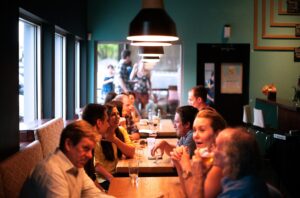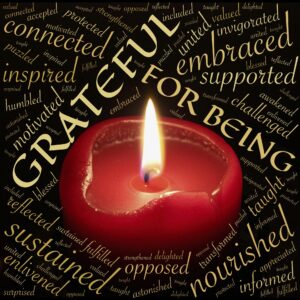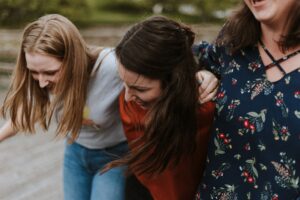
“You can’t pour from an empty cup.”
“Put on your oxygen mask first.”
Phrases like these suggest an overly simplistic and logical approach to navigating what might be a stressful holiday season in our lives, but as the readers of this publication are well aware, there is a difference between the cognitive understanding of something and the embodied experience of it.
When it comes to the holidays, people have myriad responses. Underneath the traditions and trappings the season brings, most of us really just want to feel connected to something or someone. Connection in and of itself is a  beautiful and neurobiologically sound plan. What we’ve learned from Stephen Porges (2011) is that social engagement is a feature of a higher-level functioning human nervous system. You might find it easy to think of a time you felt connected to someone else, and in turn assign high value to an overall sense of connectedness in your life. And, just as easily, you might have memories of feeling alone or disconnected.
beautiful and neurobiologically sound plan. What we’ve learned from Stephen Porges (2011) is that social engagement is a feature of a higher-level functioning human nervous system. You might find it easy to think of a time you felt connected to someone else, and in turn assign high value to an overall sense of connectedness in your life. And, just as easily, you might have memories of feeling alone or disconnected.
People who may or may not identify as introverts can also readily bring to mind the many pitfalls we can experience with an intense focus on connection. We might ignore (or be completely unaware of) our own needs, choosing instead to put the other person first. We can become so busy chasing connection that we find ourselves depleted, stressed, and no fun to be around by the time we get there. Most noticeably, perhaps, is the effect on those closest to us – our partners and children. That moment we lose our temper or regress into some earlier form of survival reactivity, we know we have jumped the track and lost alignment with what was most important.
Knowing that you tend to overschedule and end up yelling at your family is different than establishing a connection to the felt sensation of it and being able to identify that sensation in the earliest of stages, while there’s still time to shift. As you navigate the upcoming holiday season, consider the following somatic mapping practices to help you shift from a reactionary state to a mindful place, where you can sense into what you are feeling and choose how you want to react.
Anchor the experience you’d like to have with somatic mapping. Begin by imagining scenes from your desired holiday season. Perhaps you have a past experience you can draw upon. If you’re into journaling, you might write it out; artists might choose a creative medium to elaborate upon their visions. You might be a person who feels a strong connection to visualization and find it easy enough to simply bring ideas to mind. The way you get there is less important than getting there, which is to focus intently in a way that brings sensation into your body.
If you have trouble noticing any sensations, you might like to try starting instead with a word (or words) for the experience you’d like to have. Remember that the word needs to represent what you want to experience, not what you don’t want to experience. Words like connected, seen, strong, or joyful, instead of “not ignored” or “not talked over”. Once you’ve identified words that describe your desired experience, think of a time in the past when you felt that feeling – as intensely as you’re able to recall. If you haven’t yet experienced the general feelings you’re hoping for this holiday season, imagine what it would be like if you did.
 When you’re noticing sensation changes in your physical body as a result of your visioning, writing, or artistic expression, begin to hone in on those sensations. You might begin by noticing where you experience sensation and then zoom in to notice as much detail as you are able. Try to access a sense of open curiosity and give yourself as much time as needed for the sensations to be as clear and expressive as you think they can be.
When you’re noticing sensation changes in your physical body as a result of your visioning, writing, or artistic expression, begin to hone in on those sensations. You might begin by noticing where you experience sensation and then zoom in to notice as much detail as you are able. Try to access a sense of open curiosity and give yourself as much time as needed for the sensations to be as clear and expressive as you think they can be.
The next step is to “download” these anchor sensation maps into your memory. Again, choosing a modality for expression that suits you and this experience you are imagining; perhaps writing out a description of the sensations, drawing/painting how and where they are in your body, or maybe expressing it verbally by sharing this exercise with a friend.
An optional step is to also create a visual anchor for the experience you want to have. This could be what you produced in the above step, or you can create something new that easily brings the “downloaded program” back to your physical body. You can use a photograph, a collage of words and/or images, or a symbol to remind yourself.
Create a contrasting somatic map for reference.
While you might bristle initially at the idea, imagining either a future experience or bringing to mind a past experience in which things have not turned out how you’ve desired during the holiday season provides you with another valuable somatic reference point: contrast. No need to “download” this body map of undesired sensation. As Rick Hanson (2016) illustrates, our brains are like velcro for negative experiences.
Utilize your somatic maps for staying aligned.
When you notice your undesirable sensations creeping (or blowing) in, shift so your body feels a different way and sends a different signal to your brain. In tune with Porges’ Polyvagal Theory (2011), you might choose a sensory experience that is comforting or reminds you that you are safe. For example, scent is a common sensory experience that comes to mind. No need to pick up a guide to essential oils; your own internal guidance system gives you just the feedback you need to know what scent would help you stay most aligned. Explore different scents, for example, noticing how cinnamon or evergreen or lavender affects your physiology. (This is also a fun mindfulness strategy to share with a child in your life.) Alternatively, you can use your sense of touch by wrapping up in a warm blanket or asking for a hug from someone you love. The hug also carries the added benefit of utilizing your social engagement system, which Polyvagal Theory tells us is an evolutionary step-up from fight/flight/freeze.
Another strategy you might consider is one you may already be familiar with from Peter Levine’s work with Somatic Experiencing (1997, 2010). To try it, simply notice things around you; allowing your head and eyes to look up, down, and to each side. This noticing draws on a positive feedback loop in our brains that evolved long ago when our ancestors used it to survive. Being aware of the environment back then meant not getting eaten. We can draw on this strategy today, despite the lack of predatory animals in our environments.
People also often discover that sometimes the simple act of bringing awareness to the sensation and holding it with openness and curiosity can begin the shift.
Use your anchor and contrasting somatic maps for decision-making. We are often flooded with decisions during the holiday season: when to visit your in-laws (and for how long), finding a non-screen-based gift for your tween, whether to exchange gifts with your partner, the company parties, staying connected to your food plan and yoga classes. When decisions need to be made about how you’ll spend your time or which actions to take, try envisioning each option and notice your corresponding body sensations. Which options feel most aligned with your desired somatic map?
 Support your somatic mapping with good ol’ fashioned cognitive strategy.
Support your somatic mapping with good ol’ fashioned cognitive strategy.
Consider the following questions. You might find added value in journaling your answers or discussing them with a supportive friend or therapist.
What decisions or actions end up as ‘shoulds’ that are in direct conflict with the intelligence of my embodied brain as evidenced by my somatic maps?
What can support me in staying aligned with my desired state? Who can support me in staying aligned with my desired state?
What are some tools or practices you have in your back pocket that may be helpful if (or, when – it happens to all of us) you notice yourself off track?
Create a larger road map with those closest to you.
Utilizing this process with children, teens, partners, or others you find yourself navigating the season with has many potential benefits. One is that you have a shared frame of reference for bringing things back on track quickly when any one of you notices that you’re off track. And that means you have shared accountability and responsibility for how you spend time together and individually as the season unfolds, which could be especially useful if you’re usually the hub of decision making and find that people get grumpy with your plans along the way. Creating buy-in from the very beginning usually allows for more flow and collaboration along the way.
As with most things, practicing these strategies before you find yourself in the thick of things will provide maximum benefit when a stressful situation strikes. Keep in mind that the strategies presented in this article are not meant as a prescriptive checklist to guarantee a stress-free holiday; rather, they are offered as possibilities for support along your holiday journey. Chose what feels interesting to you and in what order and to what extent and leave the rest.
May your holidays hold many moments – big and small, shared and separate – that take up space in your heart and keep you warm through the winter.
References
Hanson, R. (2016). Hardwiring happiness: The new brain science of contentment, calm and confidence. New York: Harmony.
Levine, P. (1997). Waking the tiger: Healing trauma. Berkeley, CA. North Atlantic Books.
Levine, P. (2010). In an unspoken voice: How the body releases trauma and restores goodness. Berkeley, CA: North Atlantic Books.
Porges, S. (20110. The polyvagal theory: Neurophysiological foundations of emotions, attachment, communication, and self regulation. New York: W. W. Norton & Company.
 Jenifer Trivelli is a parent of two with a graduate degree in Counseling and more than a decade of experience working with children and families. She offers Parent Coaching, Consultation for Organizations, and Professional Development for Educators through her company, WiseMind Educational Services.
Jenifer Trivelli is a parent of two with a graduate degree in Counseling and more than a decade of experience working with children and families. She offers Parent Coaching, Consultation for Organizations, and Professional Development for Educators through her company, WiseMind Educational Services.
She received her M.S. in Counseling from OSU-Cascades in Bend, Oregon in 2009. Since then, Jenifer has pursued additional training in the fields of Interpersonal Neurobiology, Attachment Theory and Trauma. She also received certification through Yoga Calm, and facilitates mindfulness and movement for both kids and adults.
In 2014, at the encouragement of her colleagues, Jenifer published her first book, Peanut and the BIG feelings: A Guidebook for Children. As Peanut grew, the need became clear for a second book, written collaboratively with a teen, for teens, called Jamie’s Gift: A Young Teen’s Guide to Fears, Worries, & Other Life Challenges (Like Being Irritated By Other People).
To learn more about Jenifer’s work, publications, and offerings, please visit
www.wisemindservices.com







